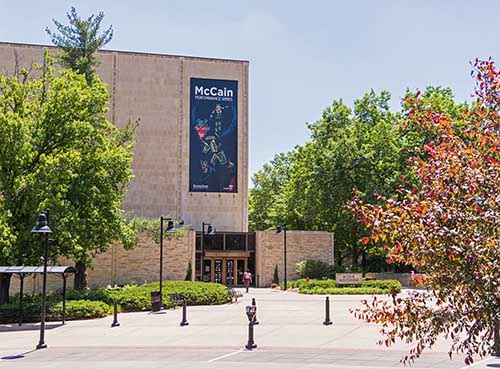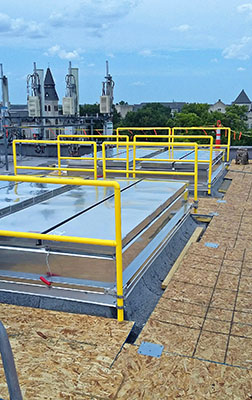Raising the Roof at Kansas State
A renovation that included the repair of storm damage to the roof of McCain Auditorium on the campus of Kansas State University was a coordinated effort that required the replacement of custom-fabricated smoke vents.
Like the mindset of its students, the administration at Kansas State University (K-State) has ambitious plans. The university seeks to become a Top 50 public research university by 2025, and the campuses are undergoing extensive renovations and additions to enhance the buildings capabilities.
Those plans include the renovation of McCain Auditorium, the hub of the university’s arts and cultural scene. In September, Kansas State announced a new project at McCain that is scheduled to start next year. The $6-million project to expand the auditorium lobby will include a two-story atrium, administrative offices, a multipurpose room, and a catering prep area.

Image courtesy of Kansas State University
McCain Auditorium at Kansas State University will soon undergo a $6-million renovation.
Before the most recent renovation plans for McCain, however, Kansas State needed to address a roofing issue on the facility that was built in 1970. In 2015, a severe summer thunderstorm pounded the region with rain, hail, and wind. More than 60 reports of large hail, wind gusts, and flooding rains were reported to the National Weather Service in Manhattan, KS, which is where K-State is located.
The storm—and years of use—took their toll on the roof at McCain, necessitating a complete replacement. Smoke vents were especially damaged by the hail. Diamond Roofing of Manhattan and Kansas City-based International Architects Atelier solved multiple issues in replacing the vents damaged by the hailstorm. The height of the building, the weight of the vents, and protecting cable and pully systems that run auditorium curtains all required problem-solving skills for the teams involved.
“This project is special because of early planning, and coordination among all the team members so that when the vents were delivered and installed, they fit like gloves,” says Majid Amirahmadi, the lead architect on the project for Kansas City-based International Architects Atelier.
Stormy Situation
The storms dropped softball-sized hail—more than four inches in size—in some spots, and nearly 58,000 buildings were in the affected area. Students at Kansas State University even escaped to a tornado bunker early in the evening. In nearby Topeka, the National Weather Service (NWS) said 3.41 inches of rain fell in just one hour. “One hour rainfall rates of 3.41 inches are considered to be a 50- to 100-year event for Topeka,” the NWS said.
The storms led to replacing the vents on the roofs. While the task seemed fairly routine, installing the six vents manufactured by The BILCO Company proved to be a complex task. Simply getting the vents on to the roof was an early hurdle.

Photo courtesy of Diamond Roofing
Diamond Roofing of Manhattan, Kansas replaced six smoke vents at Kansas State University’s McCain Auditorium. The vents were damaged during a severe thunderstorm that included large chunks of hail. The vents, manufactured by The BILCO Company, assist firefighters in bringing a fire under control by removing heat and gases from a burning building. The vents were fabricated to fit on the existing roof without the need for modifications on any of the existing roofing materials.
“The height of the building was a challenge,” says Breck Simonsson, project manager for Diamond Roofing. “Our crane was just tall enough to get the vents on the roof.”
Diamond’s team needed a four-wheel, manually operated cart to put the 1,100-pound vents into place. The carts have a weight capacity of 2,000 pounds, but the units came in two pieces. One worker pulled the cart while others on the four-person team balanced the vent and pushed the vent into place. Diamond workers placed 2-by-4 wood pieces across the cart to support the wide width of the vents.
Pully Protection
Diamond’s team also needed to construct a platform to protect the grid level under the smoke vents. The auditorium has an elaborate and complex network of pulleys to move curtains, and the platform protected the cables during installation of the vents. Construction of the temporary platform was one of the most unusual aspects of the project.
Smoke vents assist firefighters in bringing a fire under control by removing heat and gases from a burning building. They are the most economical way to add fire venting protection in large one-story buildings and are also used in warehouses and manufacturing facilities. The new vents include a positive hold/release mechanism that ensures reliable vent operation when a fire occurs, and includes gas spring operators to open covers in snow and wind.
Amirahmadi said the entire process required careful and consistent communication between the school, roofing contractor, and architect to ensure the project went smoothly. “We coordinated with the school calendar and activities at McCain Auditorium and recommended to bid this project in March,” he says. “We wanted to make sure there was enough time to receive bids, review shop drawings, and fabricate smoke vents.”
A Campus on the Move
K-State embarked on an ambitious campus improvement program in 2013. “Kansas State University’s facilities and infrastructure must be able to meet the demands of a growing institution as we become a Top 50 public research university,” then-President Kirk Schulz said at that time.
The projects included renovations at the college’s football stadium, recreation complex, equine center, engineering complex, and art museum. One of the costliest projects was a $56-million plan to expand the chilled water plant. The efficient central utility plant provides the anchor for campus expansion, and the building can hold four 2,500-ton chiller units to provide cooling for future expansion.
The upcoming renovation at McCain Auditorium will not approach anywhere near those numbers, but as the campus’ cultural hub it will be equally significant. The $6-million project is 100-percent funded by private gifts.
“The McCain Auditorium expansions project will enable the university to further enhance the cultural learning experience for students and community members by presenting exceptional performing arts programs that connect and engage artists and audiences,” Kansas Ste President Richard Myers says.
The roofing project was particularly significant for Simonsson. “Diamond Roofing and Kansas State University have a wonderful relationship and we always enjoy the opportunities to work on campus,” Simonsson says. “For me personally, being a K-State graduate, it will be a project that I look back fondly on for many, many years.”